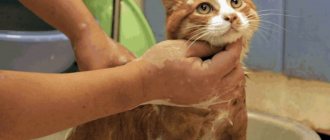Does bathing a cat feel like torture? Find out how to carry out the procedure painlessly for the pet and its owners.
Even those who have never kept them at home are well aware of the relationship of cats to water. Purrs can't stand her and everything connected with her! And if there is a need to buy a cat, both the pet and its owner receive stress from the procedure, which often resembles an execution.
This happens because bathing rules are not followed and it happens in a hurry. Below are some tips that, if you listen to them, will not turn the bath into your cat’s favorite pastime, but will at least make it tolerable and harmless.
Do cats need to be bathed?
There is an opinion that cats are extremely clean animals, so they do not need bathing at all. Like, if a purr does not sleep, does not eat or does not play, he licks himself and puts his fur in order. This is partly true; healthy cats are always concerned with their own hygiene. But washing animals living in the house, or, especially, on the street, is mandatory.
IMPORTANT: Environmental conditions today have changed a lot. Not only people, but also their pets suffer from harmful environmental factors. Bad air, polluted water and synthetic food have a bad effect on the condition of the skin and coat of cats. One way to care for them is bathing.
A domestic cat is bathed once every 3 months.
You should definitely bathe your cat if:
- He is a stray or taken home from the street if he lives in the courtyard of a private house, goes outside for a walk every day or during the “wedding season”. If a cat returns from being outside dirty, with matted fur, water treatments are equally necessary for him and his owners. He will recover quite well on his own. But is it necessary for all this dirt to get into the animal’s gastrointestinal tract? And while it rests, traces of dirty paws will remain in the house on the floor and on the furniture. Contact with a walking cat until it is washed is contraindicated for a child living in the house.
- If he gets dirty. A cat that has gotten into something sticky, inedible or toxic needs to be bathed immediately, before it begins to lick itself.
- If he sheds. During the molting period, cats lick themselves many times more often and more intensely; with their tongue they collect fallen hairs from their fur coat. These hairs clog the stomach, and if they are not regurgitated, they cause the animal to experience discomfort and problems with stool, and refuse to eat. Representatives of long-haired breeds may even experience intestinal obstruction. If you buy a shedding cat, it will be easier for him.
- If his undercoat is too dense. In this case, the cat cannot wash itself thoroughly.
- His fur gets too greasy. This happens due to the peculiarities of the functioning of the sebaceous glands or due to illness.
- He got fleas. You will need to bathe with a special anti-parasitic shampoo.
- He is hairless. Hairless cats must be bathed once a week. By the way, many sphinxes and similar cats love to swim.
Hairless cats are bathed once every 1-2 weeks.
IMPORTANT: Bathing is a mandatory procedure for a cat participating in an exhibition or competition.
When is it not permissible to wash cats?
There are several contraindications for bathing cats:
- the animal is scared or aggressive;
- the pet has recently experienced severe stress;
- the cat has recently had surgery (you must wait at least two weeks);
- the animal is sick or has significant skin damage.
You should also not bathe your cat immediately after eating.
If your pet has fleas or lice that cause it to constantly itch, in order to avoid intoxication of the pet, you should not wash it frequently with anti-flea shampoo.
How often can you wash your cat and at what temperature?
Has anyone ever wondered why cats are afraid of water? How justified is their fear? For animals, everything is much simpler; they are not subject to groundless panic. The fear of water in cats is due to the following:
- After swimming, they are at risk of hypothermia or overheating. The air cushion formed between the skin and fur of the cat warms it. After bathing, it disappears, the animal freezes. Also, the coat, naturally moistened with sebum, protects the cat from the scorching rays of the sun. A washed pet loses this protection.
- There is a risk of infection. The cat's sebaceous glands produce a secretion with antibacterial properties. During bathing, it is washed away, leaving the animal defenseless against bacteria, fungi, and other infections.
- Wet wool smells. Cats are by nature nocturnal animals and hunters. They have strong camouflage instincts. Purrs carefully bury feces behind them and carefully lick their fur coat so as not to emit odors. Washed cat fur smells very strongly, and this makes the cat very worried.
Bathing is stressful for a cat.
IMPORTANT: Bathing a cat is a necessary procedure, but you cannot overdo it. Frequent water treatments can harm your pet.
Therefore, you need to know how often to wash your cat. Veterinarians recommend:
- regularly once every 2-3 months, if the animal is healthy
- more often as needed and after consultation with a specialist
IMPORTANT: A cat’s body temperature is higher than that of a human and is 38-39 degrees. The most comfortable water for bathing an animal will be water at approximately the same temperature, but not lower than 37 degrees.
Features of washing cats of different breeds
There are exceptions to any rule.
Hairless and long-haired cats often need a water procedure. The skin of sphinxes, for example, produces a lot of oil, how often should it be washed then? To prevent blockages of the glands, it is recommended to arrange water procedures as dirty plaque appears in the folds of the skin. Scottish Folds do not need to be bathed at all, it all depends on the condition of the pet. Obese individuals should be helped to maintain hygiene as they may not be able to reach certain areas of the body to lick themselves. In such cases, it is advisable to combine bathing cats with physical movements.
How and when to wash a kitten for the first time and with what?
Unless there are any special circumstances, a mother cat successfully cares for her babies, including their fur. In the first month from birth, healthy kittens do not need bathing.
You need to wash your kitten for the first time at the age of 3-4 months.
IMPORTANT: Veterinarians advise giving a kitten a bath for the first time at the age of 3-4 months.
It is not recommended to bathe younger kittens because:
- baby may get scared
- if he's with his mom, she might not recognize him as smelling like shampoo
- The baby has not yet established thermoregulation, he may freeze and get sick
IMPORTANT: Kittens that have been vaccinated should not be bathed for 10-14 days.
So, the decision was made to wash the kitten. What's the best way to do this?
- The procedure should be carried out 2 hours after feeding the kitten.
- It is necessary to prepare the bathing area so that cat shampoo and two terry towels are at hand. How to choose a shampoo can be read below.
- It is better to bathe a kitten not in the bathtub, but in the sink and basin. Lay a terry towel or cotton sheet on the bottom.
- Approximately 5 cm of water is collected in a sink or basin. Her temperature is measured. 38 degrees is the optimal indicator.
- It is better to turn off the tap while bathing the kitten; the noise of the water may frighten it. You can wash off the shampoo with a ladle or a mug. If the wool is dense, it can only be washed with running water; the stream from the tap or shower should not be under high pressure.
- The kitten should not be immersed in water abruptly, starting with its hind legs. At the same time, it is important to stroke him and calm him down.
- Perhaps, like a child, a kitten will tolerate bathing more easily if it has balls and toys - squeakers - that will distract it from the unpleasant procedure.
- You need to water the kitten's body very carefully, making sure that water does not get into the eyes and ears. The shampoo should be rinsed off the fur thoroughly.
- After bathing, the baby should be wrapped in a towel to prevent him from freezing. When the towel gets wet, it should be replaced.
- Dry the kitten's fur with a soft brush or hairdryer if he is not afraid of it.
To calm your kitten while bathing, you need to talk to him. Your pet's favorite toy will also help.
IMPORTANT: The success of subsequent baths largely depends on the kitten’s first bath. If it went smoothly, the adult animal will treat the procedure calmly and indifferently. If the baby has experienced stress, in the bath he will be a real demon, which will be difficult to cope with even together.
Kitten's first bath
You should start bathing a kitten at 4 months of age, not earlier. Babies are extremely sensitive to temperature changes, and improper bathing can lead to serious consequences.
You can start training 2 weeks after the complete change of teeth. For the process to go smoothly, you need to convince the kitten that water is not dangerous. To do this, place a bowl of water in the room and throw rubber toys there. The baby will become interested and try to play with them.
Then you can wash your paws, under the tap or in a basin. Pour some water into it and place the kitten. If the baby does not run away in panic, he is already ready for water procedures.
If fear is present, you can distract your baby with squeaky toys while washing. If you have a helper, ask him to blow soap bubbles. While the kitten is watching them, you can have time to wash it completely.
How to wash a cat if she is afraid of water?
It is important that water does not get into your cat's ears while bathing.
It is advisable to bathe an adult cat that is afraid of water and struggles to get out of the bath together.
- Fill the bath with water at a level of 10-15 cm, depending on the size of the cat.
- The water is turned off.
- The animal is carefully lowered into the water, its fur is wetted with a sponge, very carefully. Never immerse a cat in water with its head.
- The shampoo is diluted with water according to the proportion indicated on the package. They lather the animal's fur with it.
- Remove the shampoo immediately or after some time, scraping off the foam with a brush, watering the animal from a ladle or shower under thin streams.
- Like a kitten, dry and warm the cat with a towel. Change it when it gets wet. It is advisable to dry an animal with long hair with a hairdryer with warm air.
- If after bathing the cat decides to retire and lick itself, there is no need to disturb it.
After bathing, the cat needs to be warmed and dried.
IMPORTANT: To make bathing a cat comfortable, you need to take into account not only the temperature of the water in the bath, but also the air temperature in the room. It should not be below 15 degrees Celsius, otherwise the pet may get pneumonia.
Preparing a cat for a bath
Fish for cats - examples of what is and is not possible
Preliminary preparations include:
- nail trimming;
- combing and trimming clumps of stray hair;
- selection of a suitable place - for large individuals a bath is suitable, for children - a basin or washbasin;
- removing all foreign objects - washcloths, cans of hair and skin care products.
Special shampoo for cats
To wash an animal you will need:
- cat zoo shampoo;
- cotton swabs or a special cap covering the ears - used for all breeds, including Scottish Fold;
- soft sponge - for the head;
- large terry towel - for drying after a bath;
- a small towel - for final drying of the wool.
Preparing the owner for bathing the pet
Experienced breeders advise carrying out hygiene measures together - this makes it easier to cope with possible resistance from the pet.
To wash the cat, one will have to hold the animal, the second will do the soaping and rinsing off the foam. Owners do not need special training, but when washing cats that are aggressive and hate water, you can stock up on antiseptic and adhesive tape to disinfect scratches.
Tar soap for fleas in cats: how to use?
Tar soap based on birch tar contains natural substances that have disinfestant properties. It is believed that it can remove fleas from cats.
Tar soap is used against fleas on cats.
IMPORTANT: Yes, tar soap against fleas helps, but the procedure will have to be carried out several times, perhaps a lot. The soap solution washes out or kills fleas, but not their eggs. Frequent bathing is harmful for cats; it is preferable to use modern means that get rid of fleas in 1-2 applications.
If you still decide to remove fleas from a cat with tar soap, it is done like this:
- Prepare a soap solution. 0.25 soap is grated and completely dissolved in 200 ml of warm water.
- Moisten the cat's fur with regular warm water.
- Treat the wool with a solution of tar soap so that it gets on the skin. Thoroughly wash the folds of the paws, under the tail, neck and withers.
- Keep the animal in a soap solution for 5-10 minutes.
- Carefully wash off the tar soap from the cat's fur.
- Repeat the procedure every 2 weeks as necessary (it is in 2 weeks that flea eggs hatch).
IMPORTANT: Even after thorough rinsing, a specific smell of tar soap remains on the animal’s fur, which can cause discomfort to the animal. If a cat does not respond well to the procedure for removing fleas with tar soap, it is better not to repeat it and choose another product.
Process Features
In order to wash your cat correctly, you will need to know a few secrets:
- It is prohibited to use products intended for people (so as not to violate pH values);
- Zoo shampoos can be in liquid or dry form, as well as in spray form, so the application process can be made as quick as possible for the animal.
© shutterstock
A British cat or any other cat should be bathed directly in warm, but not hot, water. You will first need to comb the coat to get rid of tangles or loose hairs. You should wash your pet briefly, without sudden movements. It is also very important to ensure that water does not get into your ears. For this purpose, you can purchase special plugs.
It is not recommended to wash a pregnant cat, as this process can cause stress to her.
In order to ensure the safety of the animal, you should place a rubberized mat on the bottom of the bathtub - this will prevent your paws from slipping. Wash with shampoo for no more than 1-2 minutes after applying the composition to the coat.
After completing the main process, you will need to blot the wool with a warm towel to get rid of excess water. It is not recommended to use a hairdryer, as it can frighten the animal (especially if it is a kitten).
How and what to bathe a British cat?
British cats have plush fur with a thick undercoat. She needs special care, which, in addition to good nutrition, taking vitamins, regular brushing, includes bathing once every 2-3 months.
British cats need bathing.
A British man is given a bath. The fact is that it will be difficult to wash out all the shampoo from his undercoat in a sink or basin. If a cat is afraid of the sound of water when washing it out of a ladle or mug, you need to comb it out at the same time with a special brush.
Shampoo for short-haired cats.
For bathing, you should get a special shampoo for the British breed.
Cleanliness is in the blood
Cats are naturally clean
Cats are naturally clean. Hygiene is important for health and well-being. Animals lick their fur every day and groom themselves. Mothers lick their babies' fur to keep them clean. But this is not enough for cat hygiene. Bathing is necessary to cleanse your pet of dust, debris and dirt. Cats carry all this dirt from the street into the house.
Twice a year, the cat begins to shed seasonally. During these periods, hair begins to fall out more often than usual. During the hygiene procedure, cats accidentally swallow hair that ends up in the cat's stomach. You will be lucky if the animal regurgitates its fur; in the worst case, intestinal obstruction may occur.
Animals can also become infected with fleas, so you need to bathe your cat with a special shampoo.
Is it possible to bathe a cat in the heat?
If a cat suffers from the heat in the apartment in the summer, the owners may want to give it a bath to refresh it. But frequent bathing, as is already known, can be harmful. Therefore, “refreshing procedures” are recommended to be carried out as follows:
- place a wet towel within reach of the animal so that it can lie on it or wet its paws
- spray the cat with water from a spray bottle
- wipe the cat's head and paws with a damp cloth
And even in these cases, the water should not be very cold so that the cat does not catch a cold.
What you need to bathe cats
Human shampoos are not suitable for washing. The pH of human and cat skin is different. The wrong cleanser can lead to dry skin, dandruff and even ulcers.
To bathe, you must purchase a special shampoo for cats in advance. If your pet has fleas, the detergent should have an antiparasitic effect.
Water temperature is about 37 C°. You will also need two towels to catch the water from the wool.
If your animal is terribly afraid of water, it is better to buy dry shampoo. The powder is applied to the coat and then combed out. It will collect dirt and grease, and also maintain friendship between the cat and the person.
Short-haired cats can be wiped with a wet towel. It will remove dirt and loose hair.
Is it possible to bathe a cat during heat?
You can bathe a cat during a difficult period of estrus; the procedure will not harm her. Moreover, some owners have noticed that after bathing their pets are so busy licking that they even calm down for a while. But this does not mean that water procedures can be performed every day. They resort to them only once.
Bathing during heat distracts the cat.
When the cat needs to be washed
photo from the site: nashsovetik.ru
If you still had to arm yourself with washcloths, brushes and other bathing equipment, you need to know how to do it correctly so that the cat does not return from the bath angry with the whole world and scared to the point of nervous trembling, and you - crippled and deafened by frantic meowing.
Yes, bathing is a stressful situation for a cat. But in some cases it cannot be avoided. For example, if you took your pet with you to the dacha, and there he played enough, simultaneously collecting all the garden dirt. Or if you urgently need to prepare your beloved furry beauty for an exhibition.
And cats are not that clean, because over time the fur sticks together and gets dirty, and in long-haired Persians or Maine Coons, tangles often form. There may even be an unpleasant smell, so you shouldn’t hope that Vaska will do everything himself, without outside help.
Should domestic cats be bathed? Necessary. Veterinarians advise doing this if:
- The pet has fleas and other ectoparasites on its body.
- The cat is dirty - this can be seen with the naked eye.
- For prevention purposes - for example, if your animal has sensitive skin prone to dermatitis, and the shampoo is medicinal.
When it's snowing and cold outside
photo from the site: VashiPitomcy.ru
Now about whether it is possible to bathe a cat in winter and how to do it. You shouldn’t completely forget about bath procedures, but it is necessary to reduce their number. That is, we don’t let the animal become covered in dirt, but we also don’t wash it more than once every four months.
At normal temperatures in the apartment, it is enough to wipe the animal dry by wrapping it in a towel. To speed up drying, you can turn on a hairdryer. The main requirement for winter swimming is no drafts.
Regular shampoo or special: what to choose
photo from website: PipCat.ru
If you preferred what you wash your hair with, we hasten to disappoint you - products intended for people are absolutely unsuitable for cats. The reason is a different acid-base balance, the risk of allergies and deterioration of the animal’s skin condition.
Some people use regular soap. Veterinarians prohibit resorting to such radical measures. The consequences of bathing a cat this way are:
- dry skin;
- hard wool;
- dermatitis as a reaction to the aggressive effects of substances contained in soap or shampoo;
- the appearance of dandruff.
It is better to choose cosmetics for tailed and mustachioed animals at a pet store. On their shelves there are different types of products: dry, liquid, sprays. The seller will help you choose the best option.
We repeat once again for those who are still wondering whether it is possible to bathe cats with regular shampoo, and are already reaching for their own Timotei or Pantene to use it for the best purposes - give up this idea. Don't skimp on your pet. A stingy person pays twice - the second time for the services of a veterinarian who will treat your cat for allergies or look for the cause of dandruff.
How often should cats be washed?
Despite the serious difference of opinion, experts recommend bathing cats periodically. To find out how often cats need to be washed, you should look at the conditions in which they are kept:
- A domestic animal that does not go outside needs bathing once a season.
- If cats live in urban environments, walk outside and return to the house, then they should be bathed more often - once every 1-2 months.
- A village animal that is allowed to roam everywhere only needs to be washed 3-5 times a year.
- Hairless breeds need to be bathed more often - every two weeks in the summer, every month in the winter.
How often should you wash your cat?
With the onset of shedding, many cats spend more time on their fur and groom themselves especially carefully. However, bathing speeds up the removal of dead hair, since mechanical manipulation and water wash away the hairs well. At this stage, the question may arise: how often should you wash your cat? There is no clear answer to this, but several factors need to be taken into account:
- General condition of the animal.
- How does the cat perceive the bathing process? Do water procedures cause severe stress?
- Breed of the animal.
“Teddy”, long-haired breeds or short-haired healthy cats with a normal, thick undercoat have no contraindications to taking water procedures during shedding. The exceptions are Rex cats, some Orientals and representatives of the Siamese variety.
How often we wash a cat depends on the degree of contamination of the fur. Experts do not recommend washing your pet more than 5-6 times a year. For pets that do not participate in exhibitions, it is enough to bathe them 2-3 times a year so as not to wash off the protective layer that is on the surface of the coat.
Representatives of long-haired breeds need bathing more often than their short-haired counterparts. For preventive purposes or if there are fleas, you need to wash the animal a few days before the planned treatment with special medications.
Can I use human shampoo?
Bathing a pet ensures not only its hygiene, but also the cleanliness of the room - after all, living nearby, we inhale the same air, touch the same objects, and maintaining cleanliness is necessary not only for beauty, but also for health. One of the most important things in keeping pets is grooming, which means weekly brushing and monthly washing.
Many dog owners have a lot of questions about this: what and how often can they wash their dog so as not to harm its health, is it possible to wash the dog with human shampoo, baby, tar and laundry soap, how to wash the dog correctly, and so on. We will try to answer these and other questions in this and other articles dedicated to caring for your four-legged pet.
It is enough to wash our short-haired four-legged friends no more than three times a year, because their skin and coat have a natural protective “lubricant”.
Frequent bathing can damage the skin by stripping away its natural protection and causing dandruff and dry skin. After walks, you can limit yourself to washing your paws or cleaning them with wet wipes .
It should be noted here that simple splashing with water in the form of a game is not considered washing, since no detergents are used and the wool does not get completely wet.
What is the best way to wash animals?
To maintain hygiene, you need to bathe your puppy with special shampoos, divided into several categories.
Pet stores offer a lot of products for caring for the hair and skin of dogs, which sometimes makes it difficult to choose - after all, it is easier to choose something universal that could be used in all cases. But this approach is wrong and cannot be justified by any arguments.
What kind of shampoo
Dogs should be washed with special shampoos designed specifically to care for their skin and coat. The selection of shampoo depends on several factors:
- Breed and age of the dog. There are specially developed products for puppies and older dogs, as well as for large and small breeds;
- The purpose of washing is simple cleaning or getting rid of lice or odor;
- Coat lengths – long-haired dog breeds require products that not only cleanse, but also soften the coat, making it easier to comb and giving it shine (this effect can be achieved by additionally using balms and masks). For example, owners of poodles should choose shampoos that prevent matting, while owners of dogs with white fur are recommended to use bleaching products.
It should be noted right away that you cannot use human shampoos or soaps, because the acid-base balance of human and dog skin is very different and shampoos intended even for delicate and sensitive human skin can harm the pet.
For complete care of your pet, it is recommended to purchase several types of shampoos - for weekly use, against fleas, dandruff and odor. And now more details.
Selection of shampoo by breed and coat type
The coat of long-haired dogs requires more careful care - washing with shampoo, rinsing with a special anti-tangle balm, etc., while short-haired dogs, for example, need softening and shine-inducing shampoos.
White wool quickly fades, acquiring a gray tint. Dogs with white coats require bleaching products. They are also suitable for light-colored dogs, giving the coat a silvery tint.
Chocolate or black coats may lose pigmentation and become dull and unattractive. For such cases, tinted shampoos are recommended, which, having a gentle effect, have a fairly long-lasting effect, saturating the animal’s fur with the necessary pigments.
Shampoos for dogs prone to allergies should be colorless and odorless. It is recommended to contain aloe vera with a moisturizing and protective effect.
By purpose of destination
Depending on the purpose of use, you can choose specially designed shampoos against:
- Fleas and lice;
- Dandruff and itching;
- Other skin diseases;
- For frequent use.
For preventive purposes or if necessary, you can use special anti-flea shampoos. They do an excellent job of killing not only adults, but also their larvae. Such funds, after some time (usually 10-14 days), are reapplied.
Detergents containing chlorhexidine have also been created, which effectively eliminates itching. Shampoos that combat the typical odor of dog hair are widely used. To prevent your dog from smelling like “dog,” use them periodically.
Washing without water
In some cases, when it is not recommended or undesirable to wash dogs, or simply if there is no shampoo, but you need to quickly tidy them up (for example, before a show) or wash off dirt during the post-vaccination period, you can use dry shampoos that do not require the use of water.
The powdery consistency of these products allows them to quickly absorb into the animal’s hair and remove dirt, followed by combing the hair.
The use of dry shampoos is also convenient in cold weather, when you do not want to expose your dog to the risk of catching a cold.
Examples of proven tools
On the Russian market you can find a lot of shampoos and other detergents for dogs - a short review will help you make your choice. Hygienic shampoos perfectly cleanse dirt from your pet’s skin and fur. Recommended:
- Mr. Bruno with celandine;
- Milord and "Doctor ZOO" for long-haired dogs with provitamins and keratin;
- “Sea” for wire-haired dogs with chitosan and provitamins.
You can choose from therapeutic options:
- SPA Comfort for problem skin;
- "Tropiclean" for itching and dandruff;
- Hypoallergenic "Gentle".
These products eliminate itching, irritation, dandruff, dryness, and brittle hair.
To eliminate unpleasant odors, tangles and make combing easier, you can purchase shampoos with conditioners, such as ROLF CLUB. And Beaphar “Bea Flea” and “Bingo” shampoos are excellent in the fight against fleas.
Tinted shampoos “White Pearl” and “Black Pearl” from the company “8 in 1” will perfectly highlight the natural color of your pet’s coat, making it more saturated and shiny.
Among dry shampoos, we can recommend Bea Grooming Powder, Elite spray with allantoin, cleansing and degreasing Dry Cleaning Secco from the Italian company Cliffi.
What not to wash
There is an opinion that you can wash your pets with anything, any ordinary shampoo, just to restore cleanliness and order. But is it? It has already been said above why dogs should not be washed with shampoo intended for humans. It should also be noted that children's products are not suitable for this role.
Scented, laundry or tar soaps dry out your pet's skin and have an unpleasant odor, so they also cannot be used for washing.
Cat shampoos, although designed for pets, are not suitable for dogs. It’s another matter if it is a combined product that allows it to be used for both cats and dogs without harming their health.
How to clean paws and ears
After walks, it is advisable to clean the animal’s paws of dust and possible contaminants. In order not to bathe them every time after a walk, you can use special shampoos for paws - “Doctor ZOO”, “Gulena”, “Four Paws”, “Shoe”.
While bathing, you should not allow moisture to get into your pet's ears, but this does not mean that you do not need to clean his ears. For this we recommend:
- Doctor VIC hygiene lotion, which fights pathogenic bacteria and fungi;
- Dekta-Forte ear drops;
- ear-cleaner lotion from Beaphar, etc.
How to wash your pet during estrus and pregnancy
Water procedures are especially important during estrus and pregnancy. After giving birth, it is advisable to refrain from washing for a week. The choice of detergent is very important. The right shampoo should contain lanolin, egg yolk or lecithin.
When washing during estrus and after giving birth, it is important to wipe the coat dry and protect the bitch from drafts and colds.
Not only the cleanliness and beauty of the coat, but also the health of the pet depends on the choice of shampoo, so it is important to make the right choice and ensure your pet’s health and comfort. Properly selected products for washing and caring for pets speak of love for the pet and the erudition of the owner.
Source: https://pesikmal.ru/uxod/soderzhanie/myt-shampunem.html











